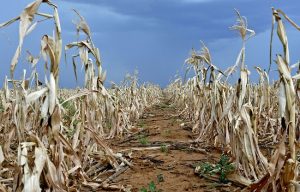The severe drought in southern Africa in 2024 was driven primarily by El Niño, rather than human-caused climate change, according to rapid attribution analysis by an international team of leading climate scientists from the World Weather Attribution group. Given the devastating impacts of this year’s drought, there is a strong need for drought preparedness in southern Africa to avoid food shortages in future El Niño years, the researchers say.

Since January 2024, countries in southern Africa have experienced low rainfall and severe drought leading to crop failure and poor harvests. From January to March, an estimated 20 million people in the region faced hunger. Water shortages, particularly in Zambia and Zimbabwe, have caused major outbreaks of cholera and other waterborne diseases.
National states of disaster have been declared in Zambia, Malawi and Zimbabwe.
To quantify the effect of human-caused warming on the drought, scientists analysed weather data and climate models to compare how these types of events have changed between today’s climate, with approximately 1.2°C of global warming, and the cooler pre-industrial climate, using peer-reviewed methods.
The study focused on Zimbabwe, Botswana, and southern regions of Zambia and Mozambique, and analysed the period from December to February, which is the peak of the rainy season. The researchers looked at two variables: rainfall and effective precipitation, the latter reflecting the difference between total rainfall and the amount of rainfall evaporated from soils and plants by high temperatures. They also looked at the possible influence of the El Niño–Southern Oscillation (ENSO), a naturally occurring climate phenomenon that alternates between El Niño, neutral and La Niña phases.
An analysis of historical weather data found that December-February rainfall is actually increasing across the study region, meaning that droughts during the peak of the rainy season are becoming less frequent. However, it is unclear whether this increase in rainfall is due to human-caused climate change because climate models suggest that climate change does not have a significant influence on low December-February rainfall in the region. The researchers say that local factors such as land use changes and other long-term drivers of climate variability could explain the increasing trend.
As for effective precipitation, the combination of historical weather data and climate models showed that it is not changing in southern Africa during the December-February period. This is likely because higher temperatures, caused by burning fossil fuels and other human activities, are increasing evapotranspiration, which cancels out the increasing rainfall.
El Niño, on the other hand, has a strong influence on low December-February rainfall, the study found. Historical weather data showed that December-February rainfall tends to be low during El Niño years. In today’s climate, with 1.2°C of global warming, similar droughts are expected to occur about once every ten years. However, in El Niño years, they are twice as likely to occur. Together, the results indicate that El Niño, rather than human-caused climate change, was the main driver of the southern Africa drought this year.
The study highlights that reliance on rain-fed agriculture makes the region vulnerable to drought. Improving forecasting and early warning systems, as well as diversifying income sources for the poorest, will help southern Africa become more resilient to drought. The researchers say it is critical the region takes additional measures to bolster food security ahead of El Niño years.
The study was conducted by 18 researchers as part of the World Weather Attribution group, including scientists from universities and meteorological agencies in Zambia, Mozambique, Botswana, South Africa, the Netherlands, the United Kingdom and the United States.
Bernardino Nhantumbo, Researcher at the Mozambique National Institute of Meteorology, said: “Tens of millions of people in southern Africa rely on rain-fed agriculture. But this year, the rains hardly fell.
“During January and February, many regions of southern Africa only received around 20% of the rainfall expected during the peak of the rainy season.”
Joyce Kimutai, Researcher at the Grantham Institute – Climate Change and the Environment, Imperial College London, said: “Over the past year, attribution studies have shown that many extreme weather events have been driven by a combination of both climate change and El Niño.
“The southern Africa drought appears to be a rarer example of an event fuelled primarily by El Niño.”
Wina Wina, Disaster Management Manager at Zambia Red Cross Society, said: “People in southern Africa know that the risk of drought increases during El Niño years.
“However, before this year’s drought, southern Africa farms had already been hit by flooding, agricultural pests and diseases.
“Our study highlights the ongoing need for improved drought resilience in southern Africa, especially ahead of El Niño years.
“Similar droughts will occur in the future in southern Africa. But with good planning and preparation, people shouldn’t have to face hunger.”


Hope we will have similar studies in Europe, America and Asia to have complete causes of CC drifts, risks trends and culprits or causative countries to Climate change and not only Africa countries. Very soon UN will begin to see reasons to say Africa countries also contribute to CC as the team reported their studies in Sahel and west Africa countries as human caused fossil fuels rather than geographical implications of desert encroachment.